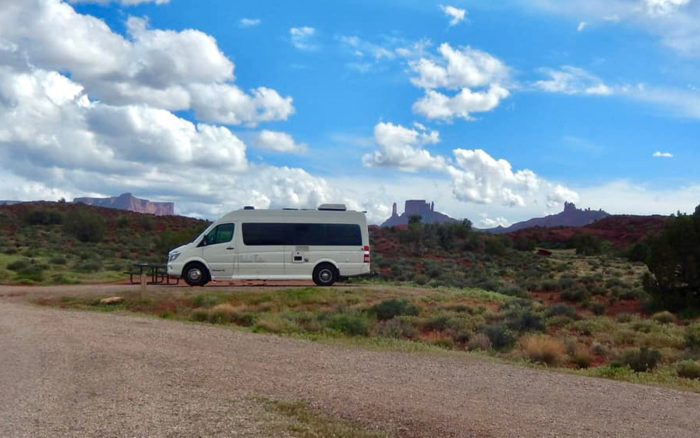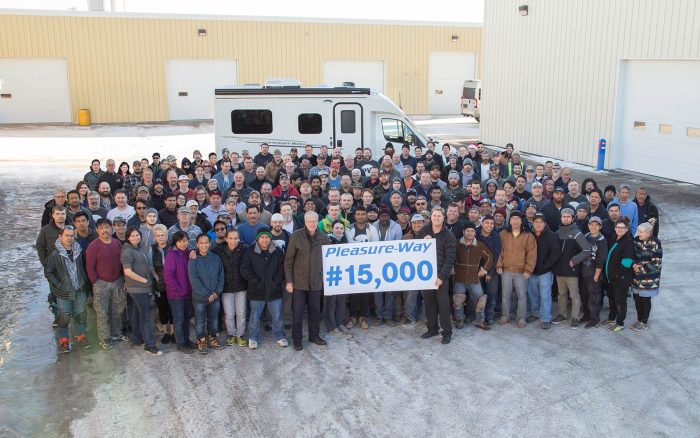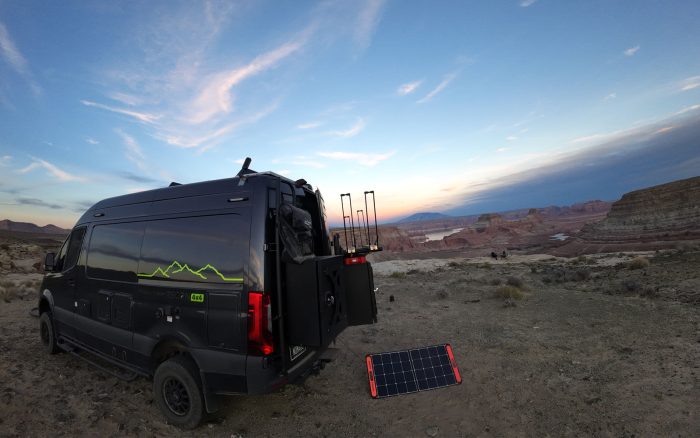PW on the Map – California Travel Guide
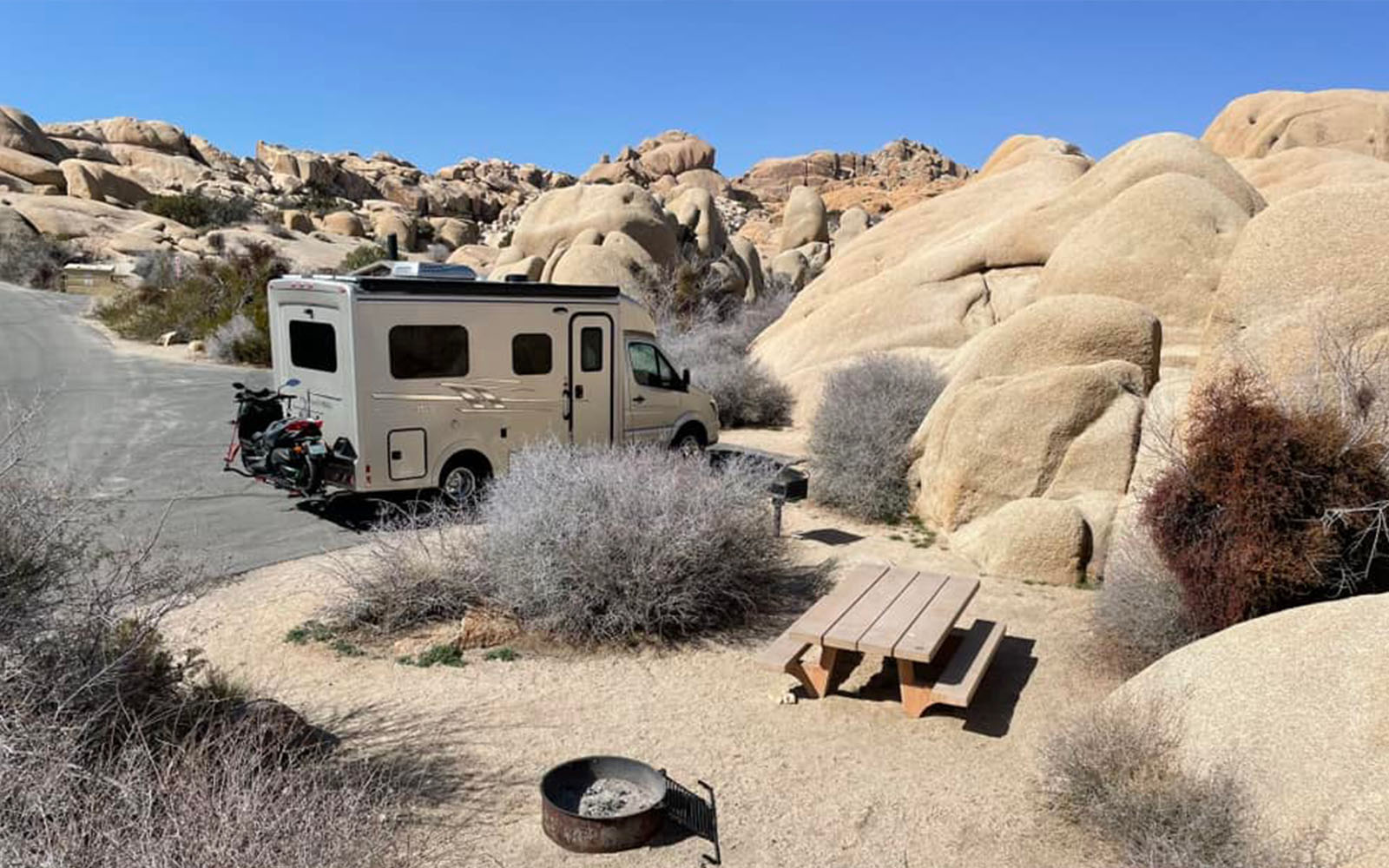
The Best Destinations for RV Travel in 2023.
RV Travel Through the Golden State
Get ready to embark on the road trip of a lifetime as we unveil the wonders of California from an RV enthusiast’s perspective. California has everything from stunning coastlines to majestic mountains, vibrant cities, and serene forests. Whether you’re a seasoned RVer or a curious traveller ready to hit the road, this guide is your gateway to RV exploration at its finest. Buckle up, and let’s uncover the beauty, culture, and adventures that await you in the RV-friendly paradise of California!
Sequoia & Kings Canyon National Parks
Cedar Grove and Mineral Kings Park are closed for the 2023 season due to winter storms and flooding damage. Neither are accessible by car.
Camping at Sequoia National Park
The 2023 season at Sequoia is different from other seasons due to a historic snowpack and a lot of flooding. Some of the campsites are closed for the season, and some are opening later with limited availability. Make sure you check your campsite options before you arrive!
Each campsite can hold up to six people and feature a picnic table; fire rings with a grill, and a metal food storage box. Ensure you check fire restrictions before you arrive, as restrictions in lower-elevation campgrounds are quite common.
Notes: Campsites are $28/night for the 2023 season and are increasing to $32 a night for 2024. Black bears are common in the area. Use the metal food storage locker that is provided on each site to protect yourself and the wildlife.
Dorst Creek Campground: Closed for the ‘23 season but usually features 33 RV-only sites. Azalea Campground: Open year-round, barring any changes due to weather conditions. Reservations will be taken up to 4 months in advance. There are no dump stations, laundry facilities, or showers at Azalea Campground.
Potwisha Campground: Open year-round, again, barring any changes due to weather conditions. There are no laundry facilities, showers, or cell phone service at Potwisha. There is a dump station for your tanks at this campground. Filter the booking system to see only RV sites.
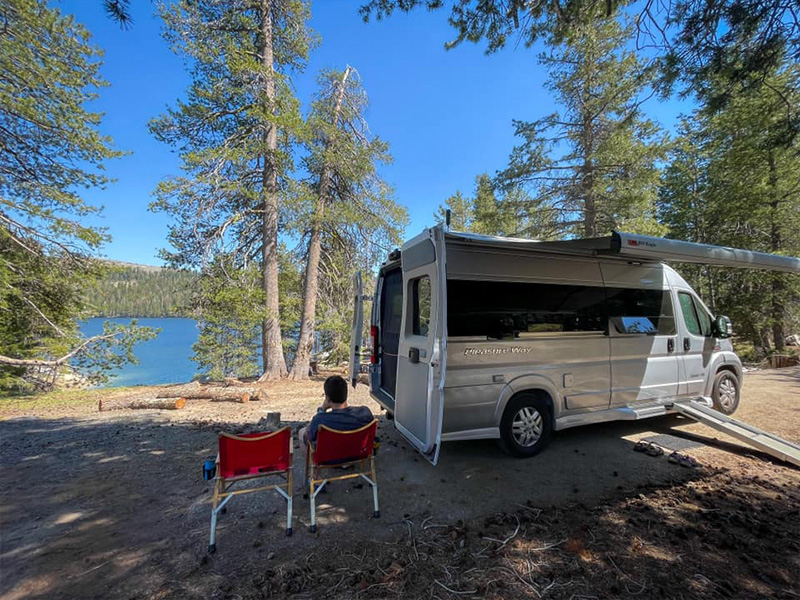
Wildlife at Sequoia National Park
When hiking or camping in Sequoia National Park, keep alert for wildlife. Rattlesnakes, bears, bobcats, and mountain lions all call the park home. Black bears can be black, brown, cinnamon, or blonde, regardless of their name. Don’t bring overly scented food onto the trails, and report to the nearest ranger if your campsite does get raided as soon as you can.
Bears are bold and sometimes aggressive in their attempts to get their hands on your food. This puts everyone, including the bears, in danger. There are fines if you don’t store your food properly, as they are meant to reduce the risk of a bear break-in. Store these items in the metal storage boxes: garbage and recyclables, soap, shampoo, toothpaste, sunscreen, first aid kids, baby wipes, lotion, hairspray, scented tissue, air fresheners, candles, insect repellent, cleaning products, pet food, tobacco products, baby car-seats, any food item, including dry goods, and any beverages.
Properly store all food, scented items, and food-related supplies left inside a provided food storage box at the trailhead. This includes coolers. Store food in your car trunk if no food storage box is available. For vehicles with no trunk, place food items low and out of sight and keep windows closed. When hiking, don’t leave your backpack and walk off to take a photograph—always stay within arm’s length of your food. Bears know backpacks are a source of food.
Food containers are highly recommended throughout Sequoia and Kings Canyon National Parks. They are available for rent at visitor centers except Cedar Grove through the Sequoia Parks Conservancy. Containers are required in the Dusy Basin, Rae Lakes Loop, North Dome, Rock Creek and Pear and Emerald Lakes areas from May 1 through October 31. Be aware of these areas’ boundary descriptions and their locations on a map. Surrounding areas within the Inyo National Forest may also have container-required areas.
You can often scare bears away by making loud noises and throwing objects before they get to your food. Be bold, but keep a safe distance and use good judgment. Never attempt to retrieve food from a bear. Never approach a bear or get near a cub.
Remove all food from packs and store it properly at night and any time you are away from camp. Bears are active both day and night. Leave packs on the ground with flaps and pockets open. Take all your garbage with you when you leave an area. If a bear does get your food, you are responsible for cleaning up and packing out all debris, and for reporting it to the nearest ranger.
These parks offer a great opportunity to see wildlife in their natural setting, but please remember that all animals here are wild. But remember, never touch or feed ANY wild animals. View animals at safe distances (the length of two city buses from more dangerous animals like bears) or through binoculars. Never disrupt, approach, or disturb animals and cause them to change their normal behaviour.
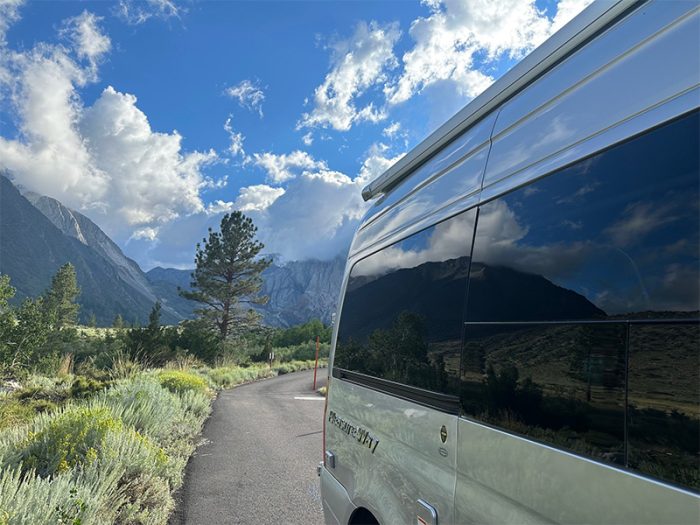
Hiking at Sequoia National Park
There are many different ways to hike at the National Park. No pets are permitted on the trails. There is a limit of 25 people on the trails each day, but no permits are required for any of the day hikes.
Day Hikes: Foothills, Giant Forest and Lodgepole, Grant Cove, Cedar Grove*, and Mineral King*.
*(closed for the ‘23 season.)
Overnight Backpacking: One of the best ways to see the park is by overnight backpacking! Utilizing the Park’s Atlas is the easiest way to plan your hike. Permits are required to camp anywhere other than the official campsites. Permits are $15 for each trip plus $5 per person during the season, and they can be purchased on Recreation.gov up to six months in advance of your trip.
Other hiking notes:
- Look out for poison oak plants.
- Bring lots of water and any water taken from the trail must be treated.
- Yield to horses and other pack animals on the trails.
- Hot weather is common, often over 100F, which can easily cause dehydration.
- High elevation can cause shortness of breath and dehydration, especially if you aren’t used to it.
- The lakes are often fed with snow melt, which makes them very cold. They aren’t the best for swimming in, and especially not alone.
- Use extreme caution when crossing streams and take a different way if the stream is very high or fast-moving.
Climbing in Sequoia National Park
Rock climbing in Sequoia and Kings Canyon National Parks can be fun and challenging. Yet, it is extremely important to have both the proper gear and necessary experience to climb any route in the park. Make sure you know all park regulations, check the weather and research your routes before you leave to climb.
Inspect all your gear before climbing, and never climb alone. Watch for slippery terrain and falling rocks, always wear a helmet, take water with you, watch for wildlife, stop climbing if you feel fatigued or out of breath, and keep an eye on the weather. Don’t use the trees or other vegetation as anchors, remove moss, lichen, leaves or other natural materials, or deface, alter, or damage any of the rock faces. Remember, leave only footprints and take only memories.
Yosemite National Park
Yosemite has ten campgrounds that can accommodate RVs, and if you plan to spend the night in your RV, you must be in a designated standard or RV campground. Make your reservation early, as most campsites fill up in Yosemite very quickly. There are no electrical, water, or sewer hookups at any of the campgrounds in Yosemite, although dump stations are available at Upper Pines Campground (all year), Wawona Campground (summer only), and near Tuolumne Meadows Campground (summer only, closed for ‘23 season). Generator use is allowed only between 7 am to 9 am, noon to 2 pm, and 5 pm to 7 pm. You may store food in hard-sided RVs and trailers as long the food is out of sight, and windows, doors, and vents are closed when you’re not in your campsite. Food may not be stored in pop-up or tent trailers, or other soft-sided campers.
Campgrounds:
| Campground | Open | Daily Fee | Reservation | Water | Notes |
| Upper Pines | Open all year | $36/night | five months before | Tap | |
| Lower Pines | April 24th-October 16th | $36/night | 5 months before | Tap | |
| North Pines | Apr. 17th to Oct. 30. | $36/night | Lottery, or five months before | tap |
| Wawona | All Year | $36 | 5 months ahead between April 10th- Oct. 23. | Tap | |
| Bridalveil Creek | Closed for ‘23 season. | $36 | 2 months ahead | Tap |
| Hodgdon Meadow | All Year | $36 | 5 months ahead between Apr. 10 – Oct. 23 | Tap | |
| Crane Flat | Closed for ‘23 season. | $36 | 2 months ahead | Tap | |
| White Wolf | Closed for ‘23 season. | $30 | 2 weeks ahead | Tap | 27’ max RV length |
| Porcupine Flat | August 9th – October 15th | $20 | 2 weeks ahead | Creek (boiling required) | Only 4 RV sites available. |
Yosemite offers guided outings in the park. These are perfect for people who are new to hiking or wilderness walks.
Custom Adventures: Design a personalized guided outing in the park.
Outdoor Adventures: Group adventures with preplanned trails and opportunities to learn about the surrounding park and its conservation efforts.
Naturalist Walks: These one- to two-hour, naturalist-led sunset, stargazing and cultural history programs take place Wednesday-Sunday in Yosemite Valley and Wawona.
Art Classes: Guest instructors, all professional artists, take guests through a four-hour outdoor art workshop in Yosemite Valley. Art Retreats are overnight workshops that give you the chance to spend several days immersed in the beauty of Yosemite as you explore a specific art medium and learn from an expert. Kid’s art classes and custom art classes are available, too!
Death Valley National Park
Death Valley is North America’s hottest, lowest, and driest area and sits below sea level. It’s a park of extremes that features striking beauty. The peaks at Death Valley are covered in snow, while lush oases harbour tiny fish and refuge for wildlife and humans alike. The park is open daily all year and costs $30 to access for a private vehicle. An annual park pass is $80.00 and allows everyone travelling with the pass holder in one single vehicle to leave and re-enter the park as many times as they wish for 12 months. No fees are required to be paid on the Birthday of Martin Luther King Jr (January 16th), the First Day of National Park Week (April 22nd), The Great American Outdoors Act (August 4th), National Public Lands Day (September 23rd), or Veterans Day (November 11th). As of June 1st, 2023, no cash is accepted to pay the fee.
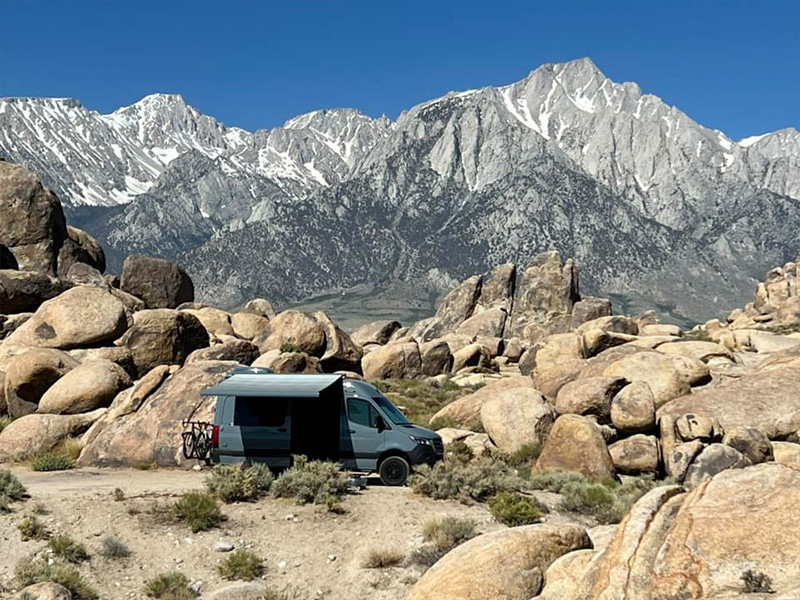
Camping in Death Valley National Park
The camping seasons in Death Valley are different than almost all other campgrounds, with their busiest season being from October to April. This is because of the extreme temperatures in the summer months. Between May and September, only a few campgrounds are open, and they are all first come, first served and unstaffed. Due to this, they can be very busy over the holiday weekends and are full most weekends throughout the summertime.
If you’re planning on camping in Death Valley between May and September, the park recommends people stay in developed campgrounds only. Travel is not recommended along the unpaved roads to access the more primitive campsites. For the winter months, there are quite a few primitive campgrounds in the Valley that have no services available. Campers have to provide their own water and pack out all trash. Most of these campsites require all-terrain vehicles with high clearance to access.
Campsites of all kinds are limited to no more than eight people and two vehicles, but there are group campsites available at the Furnace Creek Campground. Firewood is available at the Furnace Creek and Stovepipe Wells General Stores; ash-producing fires may only be made in the National Park Service fire pits. At Mahogany Flat, Thorndike, and Wildrose Campgrounds, fire is prohibited in the summer months and other periods of high fire danger. Furnace Creek Campground has a limit of 14 days per calendar year, while all other campgrounds have a 30-day per calendar year limit.
Unless otherwise posted, generator use is from 7 a.m. to 7 p.m. and is always prohibited in Texas Springs Campground. There’s a maximum of 4 pets per campground, and they must be leashed at all times. Leashes must be no longer than 6 feet. Emigrant Campground is a tent-only campground. Check recreation.gov to see RV length restrictions on all other campgrounds!
Staying Safe in Death Valley National Park
Death Valley is aptly named. The temperatures are extreme, usually with no let-up. It’s still 100+F at night during the summer months. If you’re exploring Death Valley, drink at least one gallon of water per day to replace what’s lost from sweat. Avoid hiking in the low elevations when the temperatures are hot. The mountains are cooler but can have snow and ice in winter. Whenever you’re travelling through the Valley, travel prepared. Stay on the paved roads in the summer and carry extra drinking water. If you feel dizzy, nauseous, or have a headache, immediately get out of the sun, drink water, and dampen clothing to lower your body temperature.
Don’t put your hands and feet somewhere you can’t see first when hiking. Rattlesnakes, scorpions, or black widow spiders might be sheltered there. Use caution in areas infested with rodents, as deer mice and cactus mice in the Valley have been infected with Hantavirus – a potentially fatal respiratory disease. Avoid canyons during rain storms, and be prepared to move to higher ground. While driving, be alert for water running in washes and across road dips. Do not enter mine tunnels or shafts. Mines may be unstable, with hidden shafts, bad air pockets, and poisonous gas. Do not touch mine tailings. Tailings often contain high concentrations of toxic metals and other chemicals. There are many places within the park that do not have cell phone reception. Do not depend on your cell phone.
San Fransisco
If you’re going to be in California, you have to see San Fransisco. You must see Fisherman’s Wharf and Pier 39 to see sea lions and Alcatraz Island. Grab lunch at Bubba Gump Shrimp Co., inspired by Forrest Gump. Of course, you have to see the Golden Gate Bridge and Vista Point, and you can finish the day with Coit Tower in Telegraph Hill. There’s a parking lot with bathroom facilities on the Golden Gate Bridge’s north end where many vans and smaller RVs can park for the night. Use the app iOverlander to find it!
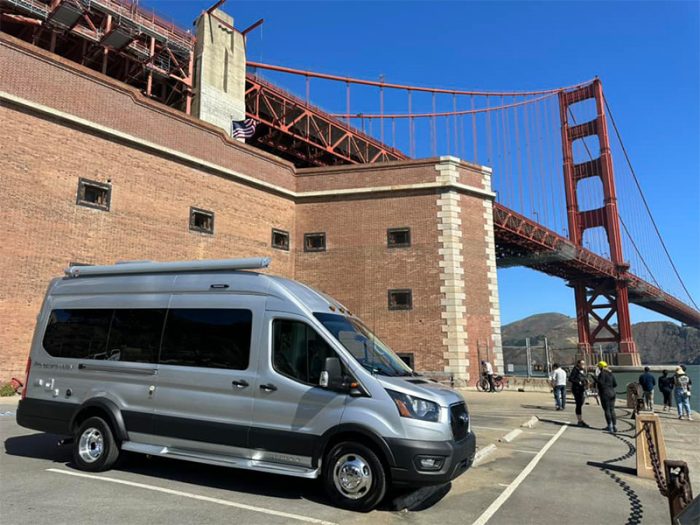
The Redwoods
If you’re an outdoor enthusiast, visiting the Redwoods should be at the top of your bucket list! The Redwoods are made up of a few different regions: the San Fransisco Bay Area, the Giant Sequoia Region, the North Coast, the Central Coast, and the Southern Coast. Go to https://exploreredwoods.savetheredwoods.org/ to find full travel guides for each area!
Weather & Climate in California
California’s weather is relatively diverse. Along the coast, temperatures are as high as 80F in the summer months, and freezing temperatures are extremely rare. The coast is foggy in the summer, usually burning off by the early afternoon. Further inland, the summers are very hot and dry, while the winters are cool and wet. Higher altitudes show more of a 4 season year, with snow in the winter. As mentioned above, Death Valley is extremely hot and dry all year, but especially in the summer.
Final Tips
California is on many people’s bucket lists. Here are some of our top tips for visiting the Golden State!
- Visit popular spots on weekdays as they’re less likely to be busy.
- Book campsites well in advance.
- California can be expensive. There’s a state tax on food and items you purchase, and tipping is customary. California has some of the most expensive gas prices in the country.
- If you’re planning to go to most of the National Parks, buy a national parks pass to save some money. California has nine national parks, each with an entry fee of $30, but the national parks pass gets you access to over 2,000 federal recreation sites, including wildlife reserves.
- Protect yourself from the sun.
If you’ve been to the Golden State, send us your photos at social@pleasureway.com!
*Feature photo provided by Janice Hicks.


